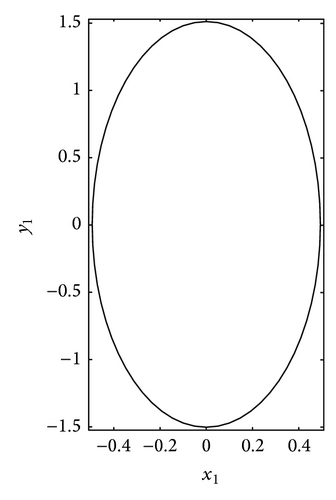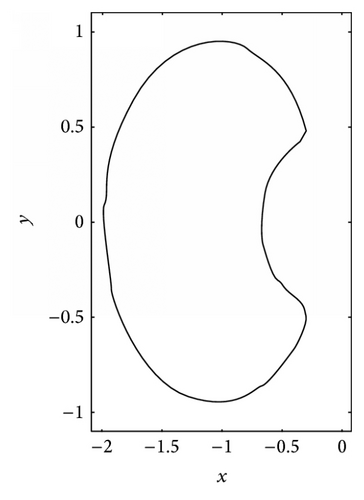Inviscid Uniform Shear Flow past a Smooth Concave Body
Abstract
Uniform shear flow of an incompressible inviscid fluid past a two-dimensional smooth concave body is studied; a stream function for resulting flow is obtained. Results for the same flow past a circular cylinder or a circular arc or a kidney-shaped body are presented as special cases of the main result. Also, a stream function for resulting flow around the same body is presented for an oncoming flow which is the combination of a uniform stream and a uniform shear flow. Possible fields of applications of this study include water flows past river islands, the shapes of which deviate from circular or elliptical shape and have a concave region, or past circular arc-shaped river islands and air flows past concave or circular arc-shaped obstacles near the ground.
1. Introduction
Shear flow is a common type of flow that is encountered in many practical situations. Milne-Thomson [1] has discussed inviscid uniform shear flow past a circular cylinder. It should be noted here that in practical situations, objects past which flows occur deviate from regular geometric shapes. In the present paper, we have examined two-dimensional incompressible inviscid uniform shear flow past a smooth concave cylinder. We have obtained a stream function for the resulting flow. It is found that the stream function given in [1] (obtained by using Milne-Thomson’s second circle theorem [1]) for the resulting flow due to insertion of a circular cylinder in a uniform shear flow of an inviscid fluid is a special case of that of the resulting flow past the concave body presented in this paper. Moreover, flow around the same body has been studied for an oncoming flow that is a combination of uniform stream and uniform shear flow. The stream function for each of shear flow past a circular arc or a kidney-shaped two-dimensional body has been calculated from the main result as special cases.
The mathematical results for inviscid fluid flows hold good for flows of common fluids like water and air; the result is valid for the whole region of a flow field except in the thin layer, called boundary layer, adjacent to the body around which the flow occurs. The results of the present study may have applications in many areas of science, engineering, and technology. Here we would like to mention a few particular areas for applications of the present theoretical work, in water flows around river islands, the shapes of which deviate from circular or elliptical shape and have a concave region, noting that rivers have shear flow across and from riverbed to surface; it should be mentioned here that the present results for oncoming flow parallel to line of symmetry of the concave body (i.e., parallel to horizontal axis) can easily be extended to the cases where oncoming flows make arbitrary angles with the line of symmetry. The result for inviscid shear flow past circular arc, obtained here as special case, may find its application in flows past circular arc-shaped islands in rivers. As air flow near the ground is shear flow, the present study may also have applications in scientific investigation of air flow past concave or circular arc-shaped obstacles near the ground.
2. The Shape of the Body


3. Mathematical Formulation and Solution
Since on the boundary of the circle , therefore, becomes zero on the boundary of the unit circle; moreover, becomes the same as as |ζ| → d. If we assume that all the singularities of lie at a distance greater than unity from the origin, then all the singularities of lie inside the circle of radius unity. Regarding , we assume that all the singularities lie inside the unit circle and or a constant on |ζ| = 1 and for |ζ| → d. Thus, the stream function in (12) possesses all the properties to represent the resulting flow.
4. Uniform Shear Flow around a Fixed Circular Cylinder or a Circular Arc or a Kidney-Shaped Cylinder
4.1. Uniform Shear Flow past a Circular Cylinder
Therefore, the result (20) represents uniform shear flow past a circular cylinder, which is in agreement with the known result [1] for the same flow.
4.2. Uniform Shear Flow past a Circular Arc
4.3. Uniform Shear Flow past a Kidney-Shaped Two-Dimensional Body
5. Flow Consisting of a Uniform Stream of Constant Velocity V Parallel to x-Axis and a Uniform Shear Flow Parallel to the Same Axis with Constant Vorticity ω past a Concave Body
The function Ψ⊗ is given by (23). Therefore, the stream functions (15), (20), (25), and (26) explicitly give resulting flow for the uniform shear flow past a concave body, a circular cylinder, a circular arc, and a kidney-shaped body, respectively. And stream functions (28), (29), (31), and (32) explicitly give the resulting flow around a concave body, a circle, a circular arc, and a kidney-shaped body, respectively, where in each of the cases the oncoming flow is the combination of the uniform stream and the uniform shear flow.
6. Conclusions
In this work, we have obtained a stream function in complex variables for inviscid uniform shear flow past a two-dimensional smooth body which has a concavity facing the fluid flow. It is found that the result for the same flow past a circle that is deduced from the central result as a special case agrees completely with the known result. Also, stream functions for the same flow past a circular arc or a two-dimensional kidney-shaped body are evaluated.
Conflict of Interests
The author declares that there is no conflict of interests regarding the publication of this paper.
Acknowledgment
The author would like to thank Professor Dr. S. K. Sen (retired) of Jamal Nazrul Islam Research Centre for Mathematical and Physical Sciences, University of Chittagong, Bangladesh, for valuable discussions during preparation of this paper.




